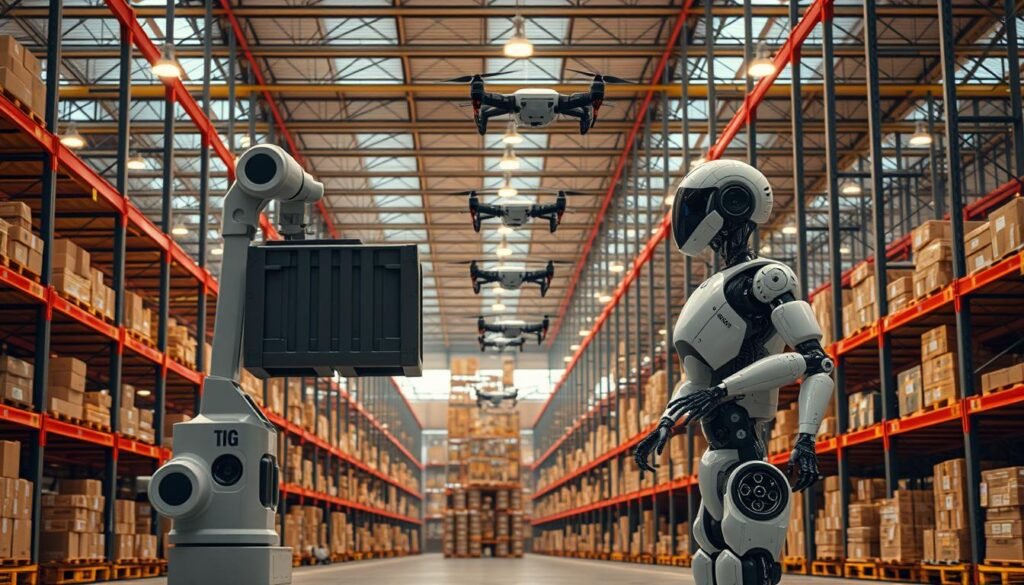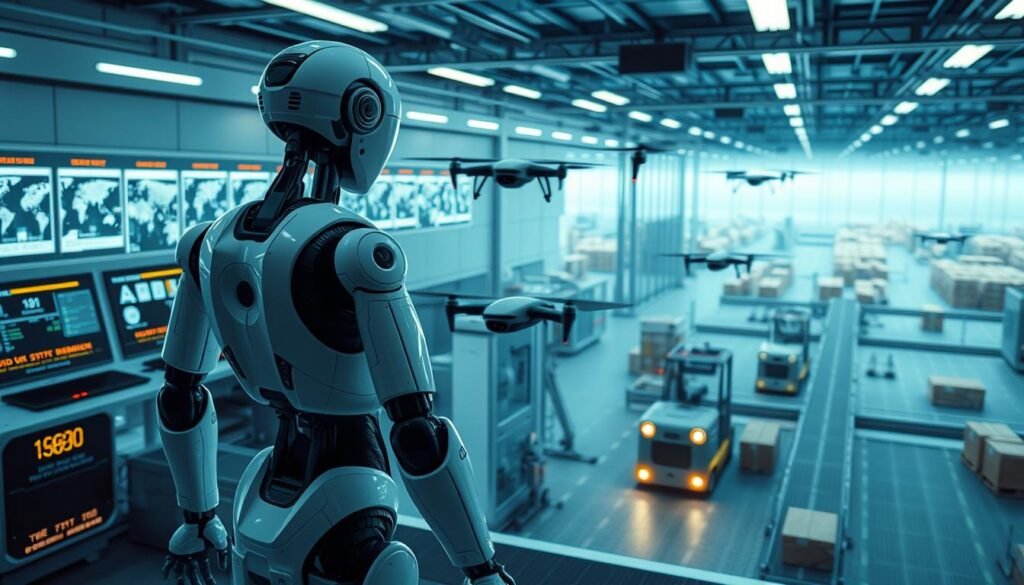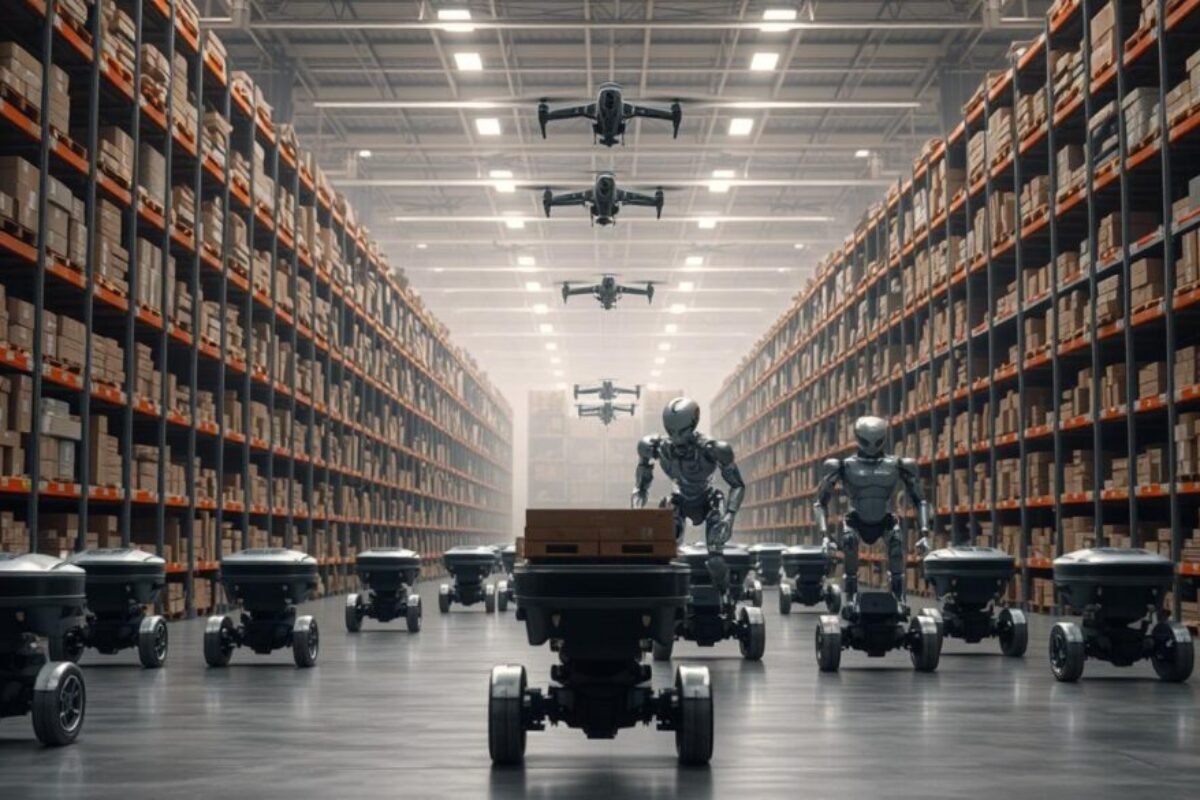Warehouse robotics, autonomous drones, humanoid robots.
Did you know that global spending on warehouse robotics is set to hit $22.4 billion by 2027? This is a huge jump from just $3.5 billion in 2018. This growth shows how robotic technology is changing the game in logistics and warehouse management.
We’re seeing a big change thanks to three key technologies: warehouse robotics, autonomous drones, and humanoid robots. These innovations are changing how businesses manage inventory, make deliveries, and handle tough tasks. They’re making things more efficient and opening doors to new levels of automation and creativity.
Key Takeaways
- Global spending on warehouse robotics is expected to soar to $22.4 billion by 2027.
- Warehouse robotics, autonomous drones, and humanoid robots are at the forefront of logistics innovation.
- These technologies enable greater efficiency in inventory management and distribution.
- Robotic technology is transforming traditional labour-intensive tasks.
- Automation is driving significant advancements in the logistics sector.
Introduction to Robotics in Warehouse Management
The use of robotics in warehouse management has changed the game. It has brought new levels of efficiency and precision. We’ve moved from simple machines to advanced robotic automation and AI in logistics. This has greatly improved many warehouse tasks.
One big plus of robotics in warehouses is better efficiency. Robots can do repetitive tasks with great accuracy, cutting down on human mistakes. Also, robotic automation means warehouses can work around the clock, less downtime, more work done.
Another key benefit is better accuracy and consistency. With AI in logistics, robots can handle lots of data quickly. They make smart choices for storing, getting, and managing inventory. This means products are tracked well and handled efficiently, less chance of them getting lost.
Also, robotics makes the workplace safer. Robots take on risky and hard tasks, keeping workers safe. This lets workers do more important and creative work. So, humans and robots work together better, making the warehouse more efficient.
| Robotics in Warehouse Management | Benefits |
|---|---|
| Operational Efficiency | Enhanced productivity, reduced downtime |
| Accuracy and Consistency | Optimized storage, accurate inventory tracking |
| Worker Safety | Reduced risk of workplace injuries, focus on strategic tasks |
Benefits of Using Warehouse Robotics

Adding robots to warehouse work brings many benefits. These changes make old ways better. The benefits of robotics show up in several areas. They include more efficiency, big cost savings, and better accuracy. These changes show how automation changes things for the better.
Increased Efficiency
Automation makes warehouses work better. Robots work hard and don’t get tired. They keep going without stopping, making things faster.
This means people can do other important things. More orders get shipped out every day.
Cost Savings
Robots also help save money. They do the same tasks over and over, which cuts down on labor costs. Plus, they don’t make mistakes like people do, which saves money too.
Robots work all the time, not just during regular hours. This means no extra pay for overtime. It helps businesses make more money.
Improved Accuracy
Keeping orders and inventory correct is key. Warehouse automation uses smart sensors and programs. This makes sure items are placed just right.
This means fewer mistakes. Happy customers are more likely to come back.
How Autonomous Drones are Revolutionizing Deliveries
Autonomous drones have brought a new era of delivery innovation to the logistics world. They are changing how we get our goods by making deliveries faster, more efficient, and better for the environment. These drones are leading the way in a technological shift, bringing many benefits to modern logistics.
Speed and Efficiency
Autonomous drones are great at making deliveries quick. They can avoid traffic, saving a lot of time. By flying the best routes, drones make sure your goods arrive fast and efficiently, meeting our need for quick service.
Access to Remote Areas
These drones are perfect for places hard to reach by other means. They can deliver medical supplies or goods to areas hit by disasters. Drones can get to places others can’t, making sure everyone gets what they need.
Reducing Carbon Footprint
Autonomous drones also help the environment. They take direct routes, cutting down on emissions and traffic. This makes our roads less crowded and helps our planet stay green.
Humanoid Robots: The Future of Warehouse Operations

Humanoid robots are becoming key in warehouse work, thanks to robotics progress. They can do many tasks like humans, making them very useful. This makes them efficient in different jobs.
Capabilities and Features
Humanoid robots are great at complex tasks in warehouses. They can do things like pick and sort items, use machines, and work with people. Their advanced tech lets them do these tasks well.
Current Applications
Humanoid robots are changing warehouse work. For example, Boston Dynamics is using them for heavy lifting. This helps reduce the work load on people. They also help track inventory accurately, making work more efficient.
Challenges and Limitations
Despite their benefits, humanoid robots face big challenges. They are expensive to make and use. It’s hard to fit them into current warehouse setups. Safety is also a big worry, needing strong rules for working with robots and people.
| Aspect | Humanoid Robots | Traditional Robotics |
|---|---|---|
| Capabilities | Advanced dexterity, autonomous navigation, object recognition | Limited dexterity, predefined paths, basic object handling |
| Applications | Picking, sorting, collaborative tasks | Repetitive tasks, simple item handling |
| Costs | High | Moderate |
| Integration Complexity | Higher | Lower |
Humanoid robots are changing warehouse work for the better. They have a lot of promise. But, we need to solve the problems they bring to use them fully.
Amazon’s Use of Robotics in Logistics
Amazon is at the forefront of logistics innovation, using advanced robotics in its operations. It explores and uses cutting-edge technologies like autonomous delivery and AI. This sets a high standard in the industry.
Autonomous Delivery Robots
Amazon’s delivery network has changed with the introduction of autonomous delivery robots. These robots use AI technology for timely and accurate deliveries. This improves customer satisfaction and makes package handling more efficient.
AI Integration
AI is key to Amazon’s logistics strategy. It helps optimize routes, predict demand, and manage inventory. The use of AI in logistics shows Amazon’s dedication to leading in logistics innovation with smart solutions.
The Role of AI in Enhancing Robotics

AI is changing robotics, making robots more independent and precise. This change makes robots more useful and adaptable. It opens doors to new and exciting uses.
Machine Learning Algorithms
Machine learning is key to AI’s growth in robotics. It lets robots learn and get better over time. This way, they can handle new situations and challenges better.
Real-time Data Processing
Real-time data processing is vital for robotics. It lets robots make quick decisions based on current information. This is super important in places where speed and accuracy matter a lot.
By combining machine learning and real-time data, AI is changing robotics. It’s making robots more powerful and capable than ever before.
Case Study: Agility Robotics’ Digit
In our look at the future of robotics, Agility Robotics shines. Their Digit robot is a true innovation.
Introduction to Digit
The Digit robot is a masterpiece from Agility Robotics. It looks like a human and has advanced sensors and software. Its ability to move like a human makes it stand out in the future of robotics.
Current Real-World Applications
Agility Robotics has used Digit in many ways. It helps with package delivery, working with Ford to get packages to your door. It also helps in warehouses, making things more efficient.
Future Prospects
The future prospects for Digit are bright. Agility Robotics sees it helping in many areas. For example, in disaster situations, Digit can help search and rescue. AI and machine learning will make it even better.
This case study shows Digit is more than a dream. It’s a real robot changing how we automate and interact with robots.
Robotics in E-commerce: Meeting Customer Demands

In the fast-changing world of e-commerce, using robotics is key. Robotics help companies improve customer happiness with new logistics and faster order handling.
Personalized Delivery Options
Now, thanks to advanced robotics, we can offer delivery choices that fit each customer’s needs. Options like custom schedules, real-time tracking, and flexible drop-off points make shopping better. This way, businesses can make sure customers have a great experience.
Seamless Order Fulfillment
Robotics are vital in making warehouse work smoother, from picking to delivering. Robots can handle inventory well, cutting down on mistakes and speeding up orders. This means faster, more accurate deliveries and happier customers.
| Feature | Benefit |
|---|---|
| Customized Delivery Schedules | Enhanced flexibility for customers |
| Real-Time Tracking | Improved transparency and trust |
| Robot-Assisted Order Picking | Increased accuracy and speed |
| Autonomous Inventory Management | Optimized stock control and reduced shortages |
Economic Impacts of Robotics in the Workforce
The use of a robotic workforce is changing many economic areas. As we move towards more automation, we must look at both good and bad sides. It’s key to balance job displacement and job creation to grasp the economic impact.
Job Displacement
Automation is making some jobs obsolete. Jobs that need manual labor are at risk because machines do tasks better and faster. This change worries about job security and calls for training to help workers adapt.
Creation of New Roles
On the other hand, a robotic workforce brings new job opportunities. As robots become part of our daily lives, there’s a need for experts in robotics. This leads to more jobs in tech, boosting the economy.
Technical Challenges in Developing Autonomous Drones
In the world of robotics engineering, we face many challenges when making drones. One big issue is making sure the drones can fly long enough. They need batteries that last long and work well.
Another big challenge is making drones navigate well. They need top-notch sensors and smart algorithms to understand their surroundings. It’s important to make sure these systems work well in different situations.
Following aviation rules is also hard. As we make drones do more, we have to follow a lot of laws and safety rules. This makes sure our drones are legal and safe for everyone.
| Technical Challenge | Details |
|---|---|
| Battery Life | Enhancing efficiency and longevity to support extended operations. |
| Navigation Systems | Developing reliable sensors and algorithms for varied environments. |
| Regulatory Compliance | Meeting legal and safety standards for autonomous technology. |
To solve these challenges, we need to work together. We need to mix new ideas in robotics with better batteries, software, and knowledge of laws. By doing this, we can make drones better, more reliable, and more useful for everyone.
Environmental Benefits of Warehouse Automation
The introduction of sustainable robotics in warehouses marks a new chapter in green technology. It brings together energy efficiency and waste management in automated systems. This way, companies can greatly lessen their impact on the environment.
Energy Efficiency
One big plus of warehouse automation is its energy-saving feature. Old warehouse setups use a lot of energy, but new tech cuts down on this. These systems use smart tech to control energy use, saving a lot in the process.
For example, automated vehicles and robots need less energy than people do. This makes them a big help in saving energy.
Waste Reduction
Another key benefit is better waste management. Automated systems make processes smoother and cut down on mistakes, leading to less waste. For instance, robots are very good at picking and packing, which means fewer damaged items and less waste.
Also, using green tech like reusable packaging and efficient sorting systems helps recycling. This makes warehouses more eco-friendly.
| Automation Aspect | Environmental Benefit |
|---|---|
| Energy Management | Enhances energy efficiency, reducing overall consumption |
| Automated Sorting | Promotes effective waste management through accurate recycling |
| Packaging Systems | Supports green technology by utilizing reusable materials |
Collaborations and Partnerships in Robotics Industry
The world of robotics is always changing. Much of this progress comes from big industry collaborations and strategic partnerships. These partnerships are key to moving technology forward. They bring together resources and expertise to tackle challenges in robotics.
Amazon Partnerships
Amazon is a big name in robotics, known for its creative approach to logistics and automation. It has teamed up with many companies to improve its services. For example, its work with Kiva Systems has changed how warehouses are managed.
These partnerships have helped Amazon lead in logistics and supply chain automation. They’ve set new standards for the industry.
Technological Synergies
The robotics industry also grows from the tech synergies between companies. When companies share their technologies, they create innovations that are hard to achieve alone. For example, Google and Boston Dynamics working together has led to big advances in AI and robotics.
These synergies are also key in healthcare robotics, where precision is critical. By sharing knowledge and resources, companies can make fast progress. This benefits users and drives the whole industry forward.
Regulatory and Safety Considerations
Robotics are becoming more common in many fields. This means we need strict rules for robotics regulation. It’s important to follow safety standards to avoid risks from these advanced machines.
Compliance with Standards
Following safety standards means following rules from groups like the International Organization for Standardization (ISO) and the American National Standards Institute (ANSI). These groups help make sure robots don’t harm people at work. They also check that robots are working safely.
Ensuring Safety of Human Workers
Keeping people safe around robots is key. Robot makers and users must have strong safety plans. This includes things like stopping robots quickly if needed and checking for dangers.
Here’s a look at some important safety features in robotics:
| Feature | ISO 10218 | ANSI/RIA R15.06 |
|---|---|---|
| Emergency Stop | Required | Required |
| Risk Assessment | Mandatory | Mandatory |
| Collaborative Operations | Specific Guidelines | Specific Guidelines |
Following these standards helps make sure robots and people work well together safely.
Future Trends in Robotics, AI, and Automation
Looking ahead, future robotics trends will be shaped by big tech leaps. We’ll explore how AI, IoT, and predictive tech are changing robotics and automation.
Advancements in AI
Artificial Intelligence is growing fast, bringing new levels of efficiency and smarts. AI advancements are making robots more independent and clever. They can now make tough decisions quickly. This boosts work efficiency and opens doors in fields like manufacturing and healthcare.
Integration with IoT
Robotics and the Internet of Things (IoT) are merging in a big way. IoT integration lets robots talk to other devices, making systems more connected and smart. This leads to better environments where data flows freely, solving problems faster and more efficiently.
Predictive Maintenance
Predictive technology is key to keeping robots running well. It uses AI and IoT to predict when parts might fail, planning fixes before they’re needed. This cuts downtime and makes equipment last longer, keeping operations smooth.
The mix of AI advancements, IoT integration, and predictive technology means a big future for robotics. As these techs get better, we’ll see huge changes in how automation works.
Conclusion
Robots are changing how we manage warehouses, deliver goods, and work together. They make things more efficient and accurate. Autonomous drones are also changing how we get our packages.
Humanoid robots and AI are showing us what’s possible with modern tech. Our look at Agility Robotics’ Digit showed us its real-world uses. It shows the big future of robotics in many areas.
We need to think about the ethics and safety of these new technologies. We must handle the job changes they bring carefully. Robotics, AI, and automation will keep getting better. They will work more with IoT, so we must keep innovating responsibly.





